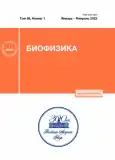Динамика температуры и массы тела у облученных мышей: зависимости "доза-эффект" и "время-эффект"
- Авторы: Зрилова Ю.А1,2, Никитенко О.В1,3, Бычкова Т.М1,3, Парфенова И.М1, Караулова Т.А1, Иванов А.А1,3
-
Учреждения:
- ГНЦ РФ - Федеральный медицинский биофизический центр им. А.И. Бурназяна ФМБА России
- Федеральный исследовательский центр химической физики им. Н.Н. Семенова РАН
- ГНЦ РФ - Институт медико-биологических проблем РАН
- Выпуск: Том 68, № 1 (2023)
- Страницы: 120-124
- Раздел: Статьи
- URL: https://journals.rcsi.science/0006-3029/article/view/144411
- DOI: https://doi.org/10.31857/S0006302923010131
- EDN: https://elibrary.ru/OAWSHK
- ID: 144411
Цитировать
Полный текст
Аннотация
Ключевые слова
Об авторах
Ю. А Зрилова
ГНЦ РФ - Федеральный медицинский биофизический центр им. А.И. Бурназяна ФМБА России;Федеральный исследовательский центр химической физики им. Н.Н. Семенова РАН
Email: uzrilova@gmail.com
Москва, Россия
О. В Никитенко
ГНЦ РФ - Федеральный медицинский биофизический центр им. А.И. Бурназяна ФМБА России;ГНЦ РФ - Институт медико-биологических проблем РАНМосква, Россия
Т. М Бычкова
ГНЦ РФ - Федеральный медицинский биофизический центр им. А.И. Бурназяна ФМБА России;ГНЦ РФ - Институт медико-биологических проблем РАНМосква, Россия
И. М Парфенова
ГНЦ РФ - Федеральный медицинский биофизический центр им. А.И. Бурназяна ФМБА РоссииМосква, Россия
Т. А Караулова
ГНЦ РФ - Федеральный медицинский биофизический центр им. А.И. Бурназяна ФМБА РоссииМосква, Россия
А. А Иванов
ГНЦ РФ - Федеральный медицинский биофизический центр им. А.И. Бурназяна ФМБА России;ГНЦ РФ - Институт медико-биологических проблем РАНМосква, Россия
Список литературы
- Г. Д. Селидовкин и А. В. Барабанова, Радиационная медицина. Том II. Радиационные поражения человека (ИздАТ, М., 2001).
- П. Д. Горизонтов, В. А. Разоренова, М. Ф. Сбитнева и др., Радиационная биология. Радиоэкология, 57 (5), 529 (2017).
- Ю. А. Зрилова, Т. М. Бычкова, Т. А. Караулова и др., Бюлл. эксперим. биологии и медицины, 173 (5), 643 (2022).
- Y. Kawakami, R. Sielski, and T. Kawakami, J. Visual. Exp., (139), e58391 (2018).
- Н. Г. Даренская, Радиационная медицина. Том I. Теоретические основы радиационной медицины (ИздАТ, М., 2004).
- K. Tanigawa, J. Radiat. Res., 62 (1), i15-i20 (2021).
- J. Terrien, M. Perret, and F. Aujard, Front. Biosci. (Landmark Ed.), 16 (4), 1428 (2011).
- В. Н. Мальцев, Количественные закономерности радиационной иммунологии (Энергоиздат, М., 1983).
Дополнительные файлы










